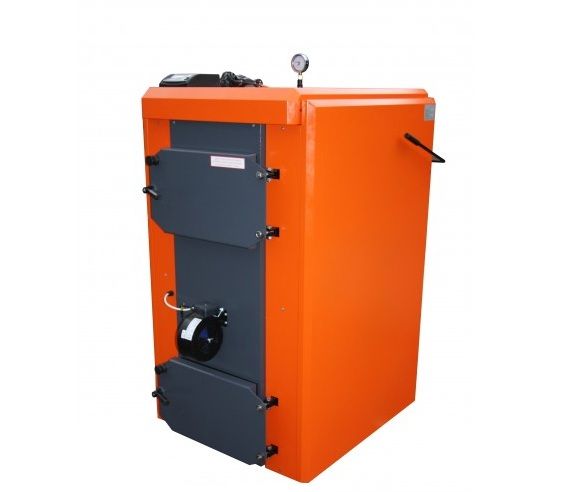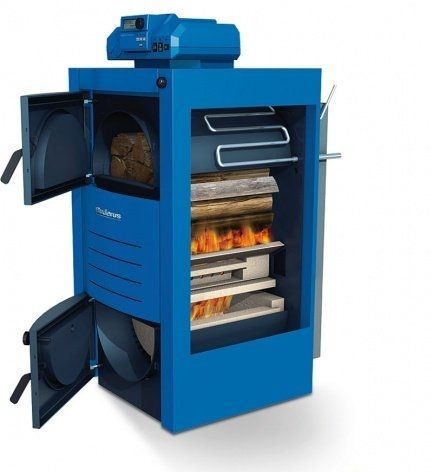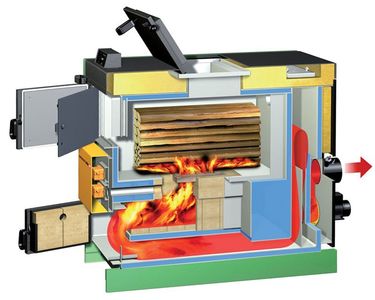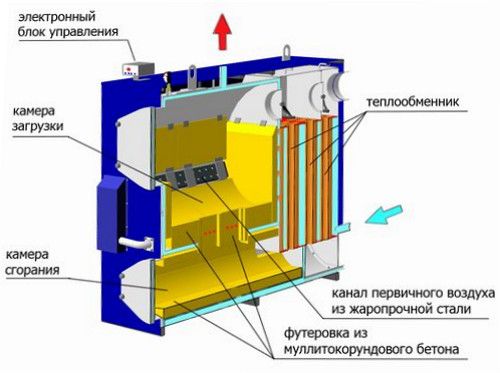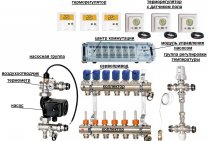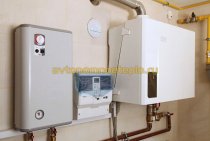Coal pyrolysis products
So, at the very beginning of our article, we mentioned that by pyrolysis from coal, you can get the following types of products:
- Solid
- Liquid
- gaseous

Now consider each type of pyrolysis products in more detail.
During the pyrolysis of hard coal, solid coke is obtained, which today is used mainly in such industries as ferrous and non-ferrous metallurgy. Coke is a more perfect solid fuel than coal, which is why it is used for smelting metals.
However, coke, although it is the main product of the pyrolysis of coal, is far from the most valuable thing that can be extracted from this natural resource. A by-product of this process is a gas-vapor mixture, which contains many chemical compounds. This mixture is separated by condensation into a liquid and a gaseous component, from which, in turn, more than 250 chemical compounds can be obtained.
The main liquid product of coal pyrolysis is coal tar, a black liquid product that is a complex mixture of organic compounds. From coal tar, by further processing, substances such as:
- Phenols
- Naphthalene
- Anthracene
- Various heterocyclic compounds
- Technical oils
- synthetic fuel
However, it is worth noting the fact that oils and liquid fuels obtained by pyrolysis of coal are unsuitable for use in internal combustion engines, since they contain many impurities in their composition. For this reason, these pyrolysis products require additional purification for further use. And this significantly increases the cost of these pyrolysis products, making their production not very profitable.
The gaseous product of coal pyrolysis is the so-called pyrolysis gas, which is a mixture of combustible gases and various chemical compounds. In many countries of the world, pyrolysis gas is now used as an alternative source of energy, primarily thermal.
If this technology is quite new for us, then in some European countries pyrolysis gas has long become a familiar fuel. In addition, pyrolysis gas, as well as coal tar, can also be used to obtain various chemical compounds. So, benzene, phenol and other substances are isolated from this gas.
- Article comments
The content of the second block
Equipment for the production of
The basis of the production process for the production of charcoal is the following mechanisms:
- Hydraulic wood splitter.
- Chainsaws.
- Scales.
- Charcoal oven.
- Electricity generator.
For the construction of the furnace, an open and level area should be equipped, the furnace itself should be of high quality, ensuring the impossibility of oxygen penetration. Otherwise, part of the raw material will not be processed, but burned.
Video: charcoal oven.
A good furnace is designed in such a way that the gases that appear during oxidation are fed into the furnace, burned out there and sent to maintain the required temperature. Such energy savings are environmentally friendly and economical.
There is also equipment in which it is possible to use only one container. In this case, the continuity of the technological production of charcoal is disrupted and downtime appears. This situation is solved by the presence of removable containers in which you can separately dry, oxidize firewood and leave it to burn out.
The modern technologies used to make charcoal are waste-free, environmentally friendly and ergonomic. The equipment does not need additional and specific care.In production, as a rule, 3 people are responsible for the continuity of the process and the automatic adjustment of machines.
Equipment differs in its variability, but they can be grouped into 3 main types:
- Mobile installations;
- Stationary mechanisms;
- Auxiliary equipment.
The first and second groups of equipment differ in the presence and absence of the possibility for its transfer. Moreover, some of the types of equipment have a single function for drying and pyrolysis.
Charcoal kilns have a weight of 6 to 80 tons. When choosing mobile equipment, you should take small models that will allow you to change their location. The choice in their favor is due to the lack of the ability to systematically supply consumables to a specific location. Mobile installations consist of modules, are quickly assembled and dismantled. They can be located without creating additional sheds and protective rooms.
Stationary installations, on the contrary, require the allocation of a separate adapted room, which can be used simultaneously as a storage of finished products.
Installation of equipment must be carried out by specialists and comply with the provisions of GOST. All installations must meet the requirements of safety and environmental friendliness, since waste and carbon residues are burned in the furnaces.
Auxiliary equipment is desirable for acquisition, since it greatly reduces costs, primarily of a temporary nature. Such mechanisms include a weighing and packing batcher, a separator.
Advantages and disadvantages of pyrolysis-type boilers
In gas-generating boilers, fuel is used most efficiently, since it burns out almost completely. This not only allows you to get more heat, but also reduces harmful emissions into the atmosphere.
Sometimes such boilers are used to dispose of production waste with minimal air pollution. In addition, the amount of ash is reduced, which reduces the frequency of cleaning (when using firewood - about once a week).
With direct combustion of solid fuel, it is quite difficult to regulate the heating of the coolant. In long-burning pyrolysis boilers, this is possible due to the control of the air supply.
The size of the firewood used can be quite large, you can use not chopped firewood. Modern models are equipped with electronic equipment that makes the control of the heating process easier and more convenient.
The disadvantages include the high cost of equipment and high requirements for the quality of raw materials. Savings on fuel over time will pay off the cost of equipment. As fuel, it is recommended to use firewood dried for 12 months, with a moisture content of 12-20%.
Otherwise, the boiler will not work with the declared power, and will also go out when the air supply is reduced. If the coolant temperature in the return pipe is low, the temperature in the primary chamber will decrease, which may cause the fuel to go out.
To avoid this, sometimes a special bypass pipe is mounted. At the same time, the design of the heating system becomes more complicated, and the cost of installation increases.
Using Forced Traction
To ensure the correct operation of the long-burning pyrolysis boiler, a supply of primary and secondary air is required. Forced draft is provided by a fan or smoke exhauster, which operates on power supply.
This allows:
- quickly increase the temperature in the combustion chamber and the heating system as a whole;
- accelerate the start of the pyrolysis process;
- extend the operation of the boiler on one load of fuel;
- automatically maintain the temperature of the coolant.
The only negative is the need for a constant supply of power. In its absence, the operation of the heating system is suspended.The way out of the situation can be the use of a natural draft boiler, which does not require an electrical connection.
For its full operation, a well-designed and mounted chimney is required. These boilers should be cleaned more frequently. Due to the absence of electronics, the likelihood of breakdowns is minimized. However, the efficiency of such boilers is lower, which is offset by lower cost.
The use of solid fuel pyrolysis boilers is one of the most effective ways to organize autonomous heating. Modern electronic equipment that controls the process of work allows you to automate the heating process.
The lack of gas or insufficient power of electrical networks forces homeowners to solve the problem of winter heating with the help of solid fuel equipment. Among these units, long-burning pyrolysis boilers stand out as a separate group (the second common, not entirely accurate, however, name is gas-generating boilers). The reason for this is their high efficiency - up to 85% and a large power range of the device - from 30 to 100%.
How to heat a boiler with pyrolysis combustion with coal
- Ignition of a pyrolysis boiler on coal - with a fully open damper, coal is ignited. It is forbidden to use kerosene, gasoline and other compounds that allow you to quickly ignite the flame. For ignition, a small amount of dry firewood is used.
- Switching the boiler to the pyrolysis mode - after firing for 15-20 minutes, the damper is covered and switched to the pyrolysis mode. From one bookmark, the boiler continues to work for up to several days.
Which coal is better for pyrolysis boilers
high temperature
The design provides for a top-loading firebox made of thick-walled steel or cast iron. Despite changes in the internal structure, it is necessary to heat the pyrolysis boiler exclusively with the coal, the grade of which is indicated in the technical documentation.
Separate requirements apply to the size of the fraction. It is better to heat automatic boilers with fine coal from 0.5-2 cm, this is due to the peculiarity of the auger fuel supply.
- Anthracite - on anthracite coal, most modern models of heating equipment work. Coal has good calorific characteristics and a small ash residue.
- Coal - the use of coal in pyrolysis boilers is also justified. This type of fuel is the standard for calculating the calorific value.
- Brown coal - has a high ash content, as a result of which, burnout of the grate is often observed. It is possible to use brown coal in a pyrolysis boiler only if there is an air preheating system before it is fed into the furnace. The use of high-ash and wet rock varieties is prohibited.
- Long-flame coal - supplied in slabs and large fractions. It got its name due to the ability to burn with a long flame, like wood. At the same time, the burning time of long-flame coal is approximately 2-2.5 times longer than that of firewood.
- Coal briquettes are made from coal waste by pressing and adding cementing compounds. Briquettes ignite quickly and have good calorific properties. As advantages, they also distinguish the almost complete absence of ash residues and slags.
optimal types
Consumption of coal in a pyrolysis boiler
environmenthard frostwarm winter
Calculations are performed as follows:
- Calculate the heated area - for this, the length of the house is multiplied by its width.
- Calculate the required boiler power using the formula 1 kW = 10 m².
- Calculate the cost of the heated area. The average cost for the heating season will be 550 kg for every 10 kW of the boiler or 100 m².
- The resulting value is multiplied by the number of months of the heating season.
Manufacturers in the technical documentation indicate how long the boiler will work on one tab of coal, list all the types of fuel allowed for use, approximate consumption and other characteristics.
Choosing a brand of a manufacturer of pyrolysis coal equipment
domestic market
- Heating pyrolysis coal-fired boilers of Russian production - manufactured products are adapted to domestic operating conditions, unpretentious to fuel quality. The most popular models are Trajan, Geyser, Divo.
- Varieties of imported coal pyrolysis boilers - heat generators manufactured in the EU countries are made of steel or cast iron. A combined design is allowed, when cast-iron grates are used together with a steel heat exchanger. The products are distinguished by high reliability, full automation of the combustion process and a long service life. The lineup of companies is popular: Buderus, Atmos, etc.
Russian boilers
How to choose a pyrolysis boiler
The market provides a wide choice to the buyer. Most of the units are the creation of Czech manufacturers, but German representatives hold the lead. Almost all models need electricity, they can run on coal, wood, or be combined.
When choosing, pay attention to:
- unit power;
- external design;
- the number of circuits.
When purchasing such a heater, it is necessary to choose its power correctly so that there is enough heat for the room. The benchmark is as follows: 1kW of pyrolysis boiler power is required to heat 10 sq. m of premises. This is taking into account the fact that the house is well insulated, the height of the walls does not exceed 3 meters. If heat losses at home are possible, the buyer is not sure about the reliability of the building, then not 1 kW, but 1.3 kW is taken into account. For example, for a room of 30 sq. m need a pyrolysis unit with a power of at least 3.9 kW (1.3 kW * 30 sq. m / 10 = 3.9 kW).
Pyrolysis boilers are technological devices, they have a large number of electronics and a variety of settings, the more expensive ones have a control panel and a ceramic furnace, which allows you to keep warm for a long time, good technical characteristics. You can also find newer models: a pyrolysis boiler in a cast-iron case (German manufacturer Dakon).
There are also models that can still function without electricity. These are OROR boilers (Czech). The essence of their work is as follows: the formation of gases occurs during the pyrolysis of fuel, their path passes through a diffusion-type burner, where they are directed to the combustion chamber.
Combustion occurs due to the secondary air. Secondary air is not amplified by the fan and is not directed to the combustion chamber, unlike most models, it is sucked into the chamber during the movement of gases. This is facilitated by a special porous tube. By opening the secondary and primary air dampers, the boiler output is regulated. Such models work completely autonomously, guarantee an efficiency of 89%.
Autonomous heating systems are relevant primarily where there is no possibility of connecting to the main heat supply. One of the modern types of such systems are solid fuel pyrolysis boilers with a long burning period.
A variety of models available for sale differ in power, equipment and price. Such boilers have high efficiency and a minimum amount of emissions of combustion products into the atmosphere. The ability to automate control makes their use more convenient.
The essence of the pyrolysis boiler
Such a pyrolysis boiler is also called a gas generating boiler. The essence of work in the pyrolysis combustion of fuel: under the influence of high temperatures and in conditions of lack of oxygen, solid fuel (lignite, coal wood briquettes) decomposes into volatile particles.It turns out the so-called pyrolysis gas. Temperature indicators of heating equipment 200-800 degrees. This chemical reaction contributes to better heating and drying of the fuel in the boiler, heating takes place, which goes in the direction of air combustion.
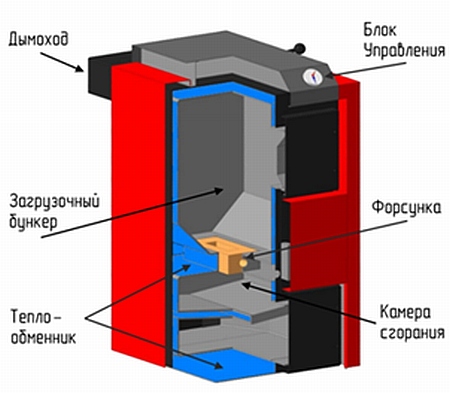
The high temperature promotes the mixing of oxygen with the released pyrolysis gas. As a result, the gas burns. Thermal energy is generated from the burning gas. It should be noted that the pyrolysis gas also interacts with active carbon during its combustion. Therefore, leaving the boiler, flue gases practically do not have harmful components. Rather, they are a mixture of carbon dioxide and water vapor. The resulting CO2 enters the environment three times less than after the operation of conventional coal or wood boilers. These units are considered environmentally friendly, do not pollute the environment.
Units of this type operate on coal and wood fuel. If you use low-quality raw fuel, the heater will lose its power up to 50%. Such fuel burns poorly, smokes, heats little and reduces the life of the boiler and chimney.
Advantages of pyrolysis units:
- power adjustable from 30% to 100%;
- the cleaning and maintenance process is simple;
- small fuel requirement;
- fuel supply per day only once;
- a large amount of fuel burns together at once;
- the use of raw fuel by a coal-fired boiler, the moisture content of which is not higher than 20%.
Flaws:
- expensive heating device;
- need electricity.
Each type of fuel burns differently. As for coal fuel, brown burns in 8 hours, and black in 10 hours. With pyrolysis boilers, savings are possible, even taking into account such disadvantages as the need for electricity, not low cost. Electricity is needed to power the fan, but it only needs 85 watts to run (like a normal light bulb). If this is a problem, then a diesel generator can handle it.
Advantages of pyrolysis type heating units
- In addition to high efficiency and the ability to control power, the advantages of this equipment include a long burning time with one tab.
- High environmental friendliness: the combustion process proceeds until the fuel is almost completely decomposed into neutral substances - water and carbon dioxide, chimneys are not overgrown with tar. By-product gaseous harmful substances are formed negligible.
- Excluded smoke in the room. No soot formation, the amount of ash generated is minimal. Simple automation makes it easy to control the unit.
- A variety of fuels: wood, wood waste, coal - this is the advantage of boilers.
- Does not require frequent maintenance: combustion products do not pollute the unit, but periodic cleaning is required. High-tech automation monitors malfunctions and prevents their occurrence.
CLAIM
1. Installation for the production of charcoal, characterized in that it is made in the form of a horizontally oriented body with refractory end and side walls, divided by vertically oriented refractory partitions into at least one furnace block, at least one pyrolysis block and a block exhaust gases, in the lower part of the housing there is at least one collector of pyrolysis gases, and in the side walls and / or partitions of the housing there are channels for the vapor-gas mixture, exhaust gases, secondary air supply and water vapor circulation, while the combustion unit is made in the form of a combustion chamber with feed openings and dampers that regulate the supply of primary air, the pyrolysis unit includes at least two cells formed by the walls of the housing and / or vertical partitions, with at least one retort placed in each of the cells, equipped with a drain pipe the steam-gas mixture channel is connected on one side to the combustion unit, and on the other side to the pyrolysis unit; , the water vapor circulation channel is connected on one side to the pyrolysis gas collector, and on the other side to the exhaust gas outlet unit, while the pyrolysis gas collector is connected on the one side to the outlet pipe of the retort, and on the other side is connected to the combustion unit.
2. Installation according to claim 1, characterized in that in the walls of each cell of the pyrolysis unit there are holes for connecting the cavity of the cell with the channel of the vapor-gas mixture and the channel for removing exhaust gases.
3. Installation according to claim 1, characterized in that the cell of the pyrolysis unit is equipped with a sealed refractory cover.
4. The installation according to claim 1, characterized in that the exhaust gas removal unit is made in the form of a chamber formed by the walls and / or partitions of the housing, with openings for connecting the chamber of the exhaust gas removal unit with channels for supplying secondary air, water vapor, and exhaust gases.
5. Installation according to claim 1, characterized in that the inlet of the secondary air supply channel is located in the end wall of the housing, and the outlet is in the wall of the exhaust gas removal unit.
6. Installation according to claim 1, characterized in that the water vapor circulation channels are located in the secondary air supply channels.
7. Installation according to claim 6, characterized in that it is equipped with a two-way cock, configured to cut off the water vapor circulation channel from the pyrolysis gas collector.
8. Installation according to claim 1, characterized in that the cells of the pyrolysis unit are made of square horizontal section.
9. Installation according to claim 1, characterized in that each retort is placed in the central part of the cell with a gap of no more than 0.4 m from its walls.
10. Installation according to claim 4, characterized in that the volume of the combustion chamber of the combustion unit is not more than 37% of the volume of the cells of the pyrolysis unit and not less than 110% of the volume of the chamber of the exhaust gas removal unit.
11. Installation according to claim 2, characterized in that the area of the holes for connection with the channel of the vapor-gas mixture of each cell is not more than 140% of the cross-sectional area of the channel of the vapor-gas mixture.
12. Installation according to claim 1, characterized in that the retort of the pyrolysis unit is made in the form of a body with a bottom, a lid and a cylindrical side wall, equipped with a gas outlet pipe connected to the pyrolysis gas collector, while the side wall is made multilayer, and the gas outlet pipe is mounted in top of the side wall.
13. Installation according to claim 1, characterized in that the side wall of the retort is formed from at least one metal sheet rolled into a roll, or from two metal cylinders coaxially placed with a technological gap.
14. The installation according to claim 1, characterized in that it contains a filter unit, a smoke exhauster and a chimney, connected in series through the exhaust pipe to the exhaust gas removal unit.
Boiler start
During the launch of the pyrolysis unit, it is worth taking into account the characteristic features in which it differs from classic boilers. The operation of the device in the gas generator mode is carried out thanks to two chambers, which are equipped with gates (flaps)
But not everyone remembers that such a heating unit should first be warmed up.
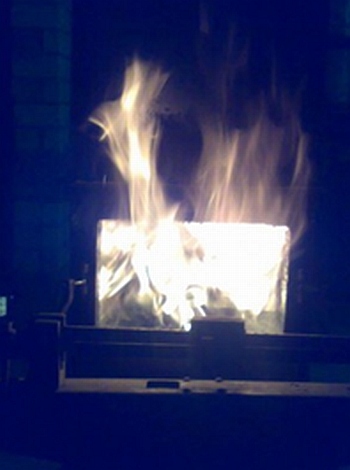
Upon reaching the temperature in the range of + 500- + 800 degrees, you can start immersing solid fuel, and only then bring the damper into the pyrolysis mode of operation, and start the smoke exhauster. A pure yellow-white flame (Fig.3) confirms the correct settings of the gas generator, that there are no toxic combustion products in the smoke mixtures.
This sequence of actions during start-up guarantees the combustion of fuel slowly and oxygen-free, the effective release and combustion of pyrolysis gas (pure), a constant comfortable room temperature for 24 hours.
The principle of operation of the pyrolysis boiler for long burning
Pyrolysis boilers of long burning are gaining considerable popularity, and especially in those areas where there is no access to gas
The operation of the equipment is based on the decomposition of organic fuel (firewood) under conditions of high temperature and lack of oxygen, followed by combustion of the released pyrolysis gases. Since the process can be conditionally divided into two stages, a firebox with two compartments is used for its flow. Fuel is placed in the loading chamber, which begins to burn. The combustion process smoothly turns into thermal decomposition due to the limited access of oxygen necessary for combustion. High temperature and low oxygen concentration leads to the formation of decomposition products: coke and pyrolysis gas. The latter, entering the second chamber, undergoes combustion already in the conditions of secondary air access. It is often forced by force with the help of a blower fan or a smoke exhauster. The combustion process takes place at temperatures above 1000°C. From the combustion products, heat is transferred to the liquid filling the heat exchanger. The final gaseous products of the process are removed through the chimney.
To date, long-burning pyrolysis boilers are considered the most efficient and economical heating equipment. The complex two-chamber device of the boiler explains its high cost. Efficiency, the highest among heating units, allows you to get a quick payback for the boiler.
Charcoal production
The advantage of a business based on the use of very cheap or free raw materials is high profitability and a quick return on production.
Nature “produces” wood in sufficient quantities, so a coal manufacturing plant can operate year-round and at full capacity.
In addition, unlike in the woodworking industry, the quality of raw materials is of little importance, which allows the use of deadwood and trees that are dry and upright.
This article will consider a detailed plan for organizing a business for processing wood raw materials into high-quality charcoal for barbecue or for further use for medical purposes.
Our business valuation:
Starting investments - from 300,000 rubles.
Market saturation is average.
The complexity of starting a business is 5/10.
Principle of operation
Unlike traditional solid fuel boilers, pyrolysis boilers use a double combustion cycle. In the process of thermal decomposition of organic substances, pyrolysis gases are released, the combustion of which leads to a large release of thermal energy.
The use of pyrolysis allows you to get more heat from the combustion of fuel. Pyrolysis (gas generating) boilers have two chambers - for burning solid fuels and released gas.
In the first chamber, combustion occurs at a low oxygen level and high temperature (200-800 ° C), this starts the pyrolysis process. The amount of gases emitted depends on the feedstock used. Wood is best suited, when burned, it releases the largest amount of pyrolysis gas.
The optimal thickness of firewood is from 70 mm, in addition to them, pellets or sawdust can be used in an amount of no more than 25%, since they do not provide sufficient combustion power.
The operation of a long-burning gas-generating boiler occurs according to the following scheme:
- The fuel is placed on the grate (refractory grate) through the loading window.
- Provide primary air supply to it.
- Ignite the fuel and bring it to the mode, achieving the required temperature.
- The primary air supply is limited by closing the valve, due to which the pyrolysis process begins.
- Pyrolysis gas with the help of a fan enters the secondary chamber, where secondary air is supplied.
- Hot gas in contact with oxygen burns, releasing a large amount of heat, which heats the coolant in the heat exchanger.
- The products of combustion are removed through the chimney.
Depending on the amount of incoming secondary air, the reaction occurs at different rates. This allows you to control the temperature of the coolant using an automatic valve, limiting the air supply to the afterburner.
With the optimal quality of the burned wood, the efficiency of long-burning pyrolysis boilers is 85-90%. This indicator sharply decreases with an increase in the humidity of firewood, since water vapor reduces the concentration of combustible gases.
Charcoal production
The technology for the production of charcoal is relatively simple, but still requires a certain culture of production and knowledge of the features of technological processes. Non-observance of technological processes leads to a decrease in the yield of coal, coal is obtained with cracks, small, smelling of tar, unburned.
|
To obtain coal from wood, it must undergo a process of pyrolysis, decomposition without oxygen. The wood decomposes, under the influence of heat, in a retort - a steel container with tightly closed loading openings, heating occurs by placing the retort in a special oven. |
The gases that are released during the pyrolysis process are discharged through a special pipe from the retort to the combustion chamber and burned there. Due to the constant flow of the emitted gas into the furnace, there is a minimum consumption of firewood to maintain combustion. Pyrolysis can be divided into three main stages, which differ from each other in control measurements and visible signs.
Drying wood is the first step. It occurs at a temperature of less than 150 ° C, moisture comes out of the raw material. The technical process just begins with the fact that birch firewood chopped to the desired size is placed in a retort, the feed opening is closed and placed in a drying chamber. The raw materials must comply with GOST 24260-80.
|
To grind blanks to the optimal size, the length is not more than 0.5 m and the diameter is not more than 0.1-0.15 m, a special machine is used - an electric wood splitter. After the wood has been dried, the retort is transferred to the pyrolysis chamber using a lifting mechanism (for example, a crane beam). There the second stage takes place - the actual pyrolysis, dry distillation. |
Due to the fact that wood consists of a whole complex of organic compounds, the process of wood decay is very complex. Organic compounds have different molecular weights, so the chemical reactions that take place between them are also different. Within the framework of this site, it makes sense to describe only in general terms these reactions, since it will be difficult to calculate or describe in detail all these reactions.
|
In general, in the process of pyrolysis, sequential and parallel chemical reactions take place, which lead to the appearance of new bonds and the breaking of old bonds that existed before heat treatment. The resulting new substances begin mutual reactions. Xylan begins to decompose first, at a temperature of 150°C, the process continues at 250°C or more. This process leads to the formation of substances such as acetic acid, furfulol and gases. |
||
|
In addition, on the surface of wood at a temperature of 170-200°C, hemicelluloses begin to split. |
||
|
Lagnin begins to decompose next, at a temperature of 200 ° C, which leads to the release of volatile low molecular weight compounds. Cellulose decomposes at 300°C. At this stage, a period called exothermic can be distinguished; it is very important for the entire charcoal burning process as a whole. During this period, pyrolysis proceeds vigorously, reaction heat is released, this occurs at a temperature of about 280 ° C. The temperature of the wood will begin to increase spontaneously until all the heat of the exotherm is released. For the next stage, calcination of coal, an external heat supply will again be required. |
The third stage is the calcination of coal. If coal was formed at the previous stage, then at this stage resins in a small amount and many non-condensable gases are separated from the formed coal. This occurs at temperatures from 350°C to 550°C. Calcination takes place in the same pyrolysis chamber.
| The final stage is cooling, packaging, storage. After the pyrolysis process is over, the retorts with ready-made coal are removed from the pyrolysis chamber one by one or in pairs using a crane-beam, and installed in a cassette for cooling. The cooling time varies depending on external factors (season, presence or absence of wind, precipitation). |
The cooled retorts are again lifted and hung above the filling machine, after opening the lower discharge openings they are emptied. Next, the coal is screened from fine fractions and dust, packaged, weighed and bags of coal are sewn up.
Packaged products are stored in a warehouse until further shipment to consumers.
The retorts freed from coal are again filled with firewood and placed in a drying chamber.
